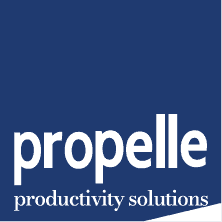Intranets come in many shapes and sizes. But what makes a great SharePoint intranet? And why is this crucial for your business? SharePoint is a go-to for intranet solutions, offering a blend of versatility and user-friendliness that is unmatched in the market. With so much control around configuration and customisation, perfecting the digital workplace experience takes consideration and knowhow.
A well-implemented SharePoint Intranet can be the cornerstone of your organisation’s digital strategy. It’s a place that brings people and technology together. But a poorly designed and configured intranet can shift collaboration to frustration. According to a report by McKinsey, the average employee spends 1.8 hours every day searching and gathering information. Clearly this wasted time across a business sends productivity out the window. A well designed SharePoint intranet will centralise information, which quickly leads to enhanced collaboration and productivity. So, lets look at why we all need great intranets and how to create one.

An intranet is a multifaceted tool that delivers a range of benefits, transforming the way organisations operate. Here’s how SharePoint does it:
Enhanced Communication Across Departments:
Quick Access to Information:
Encourages Collaboration:
Improves Overall Productivity:
Centralised Resources:
Reduces Time Spent on Searching:
Facilitates Better Knowledge Management:
Enhances Employee Engagement:
Scalability and Flexibility:
Security and Compliance:

Setting clear goals and objectives and understanding user needs and expectations are crucial first steps in developing a great SharePoint Intranet that truly aligns with your organisation’s needs and business goals.
First, establish the main goals of the company intranet. Whether the aim is to improve internal communication, facilitate better project collaboration, or streamline document management, these objectives will serve as a compass throughout the design process. It’s these clearly defined goals that ensure the Intranet is purposefully aligned with your business needs.
Equally important is the need to understand the expectations and requirements of your users. This is best achieved through direct engagement with your team, using methods such as surveys, interviews, and workshops. Such interactions offer invaluable insights into how your team operates and what they expect from an Intranet. This user-centric approach is fundamental in tailoring the Intranet to meet the specific needs of your employees. By merging these two critical steps—setting clear objectives and understanding user needs—you lay a solid foundation for an Intranet that is both functional and aligned with the unique workflow of your organisation.
Creating a user-friendly interface is paramount in the development of an employee Intranet, as it significantly impacts user adoption and overall satisfaction. A user-friendly interface should be intuitive, making it easy for users of all skill levels to navigate and utilise the modern Intranet efficiently. This involves a clean, uncluttered design, logical layout, and clear labeling of sections and features. The interface should also be responsive, ensuring a seamless experience across various devices, be it desktops, tablets, or smartphones. Incorporating user feedback in the design process can help in identifying and addressing usability challenges, ensuring the interface meets the actual needs of the users. Additionally, customisation options, allowing users to tailor their dashboard or homepage to their preferences, can enhance the personal connection and comfort with the platform. A well-designed, user-friendly interface not only improves the day-to-day efficiency of users but also fosters a positive interaction with the Intranet platform. This will boost intranet adoption, making it an indispensable communication tool in their work environment.

Utilising the appropriate content management tools provided by SharePoint is essential for transforming your Intranet into a dynamic resource hub. SharePoint’s suite of content management tools is designed to efficiently organise and manage digital content, making it easier for users to access and interact with the information they need. These tools include features for document management, content categorisation, and archiving, all of which are crucial for maintaining a well-organised and easily navigable intelligent Intranet. Effectively leveraging these tools allows for streamlined content workflows, better collaboration, and more effective information dissemination. By ensuring that content is not only easily accessible but also systematically organised and managed, SharePoint turns the Intranet into a more vibrant, useful, and engaging workspace, essential for the modern digital workplace.
Effective navigation is a cornerstone of a successful Intranet, playing a critical role in enhancing user experience and overall efficiency. A well-designed SharePoint Intranet should feature intuitive navigation that enables users to quickly and effortlessly locate whatever they need, be it a document, a contact, or a specific application. This ease of navigation is achieved through a clear, logical structure, thoughtfully organised menus, and well-labeled sections that guide users seamlessly to their desired destinations. The incorporation of features like breadcrumb trails, search bars, and customisable quick links further aids in simplifying the user journey within the corporate Intranet. By minimising the time and effort required to navigate, the Intranet becomes a more effective tool, encouraging users to utilise it to its full potential in their daily work routines.
Introducing intelligent automation tools, such as AI and machine learning, into a SharePoint Intranet can markedly elevate its efficiency and effectiveness. These cutting-edge technologies play a pivotal role in tailoring the Intranet experience to individual user preferences and needs. By analysing user behavior and patterns, AI can personalise the content and interface for each user, making the Intranet more intuitive and user-friendly. Furthermore, machine learning algorithms can continually refine the relevance and accuracy of the content presented, ensuring that users always have access to the most pertinent and up-to-date information. This not only streamlines the user experience but also significantly enhances the overall utility of the Intranet as a key tool in an organisation’s digital ecosystem.

A great SharePoint Intranet distinguishes itself with robust search capabilities, an essential component for enhancing user experience and operational efficiency. The power of efficient search features cannot be overstated in a digital workspace where quick access to information is pivotal. By integrating advanced search functionalities, users can navigate vast repositories of data and documents with ease, significantly reducing the time and frustration typically associated with searching for specific information. This efficiency is achieved through well-structured indexing, use of metadata, and intelligent search algorithms that understand the context and relevance of user queries. The result is a more streamlined and productive digital environment where essential information is readily accessible ensuring user satisfaction, which is a prerequisite for the modern experience employees expect. Efficient and effective intranet search is a powerful tool when empowering users to focus more on their core tasks and less on the laborious process of sifting through information.
Central to the success of a SharePoint Intranet is the quality of its content. Content must be tailored to the diverse needs of different user groups within the organisation, ensuring relevance and usefulness. Regular updates and reviews are crucial in maintaining the accuracy and currency of the information provided. This can be achieved through scheduled content audits or by enabling users or to flag outdated information. Incorporating dynamic content strategies and use of a news carousel, featuring company news, employee stories and industry updates, adds value and keeps the content engaging. Interactive elements like quizzes and forums further enhance user engagement and interaction with the Intranet.
Empowering users to contribute to the Intranet also plays a pivotal role. Encouraging user-generated key content, like blogs or team updates, fosters a sense of ownership and inclusion. Assigning content editors or champions in various departments ensures the continual relevance and accuracy of content in specific areas. Additionally, providing training and clear guidelines for content creation helps maintain consistency and quality. Regular feedback from users is essential for continuous improvement, ensuring the Intranet evolves to meet the changing business requirements and needs of its workforce. A successful SharePoint Intranet hinges on its ability to provide relevant, accurate, and engaging content, making it a valuable and dynamic resource for the entire organisation.
In essence, the beauty of a SharePoint Intranet lies in its ability to resonate with the needs and culture of the organisation as well as enhancing operational processes and efficiencies. A great SharePoint Intranet is key to digital workplace design. It should be seen as an evolving digital ecosystem that grows and adapts with the business. By prioritising planning and engagement, the SharePoint Intranet can be customised to the needs of employees and teams. Its powerful automation and search features will ensure its efficient and effective for the business function. With a well designed intranet, that houses relevant and engaging content, an organisation can unlock their full potential and becoming a powerhouse of productivity and connection.

© 2024 Propelle Pty Ltd